This article has been reviewed according to Science X's editorial process and policies. Editors have highlighted the following attributes while ensuring the content's credibility:
fact-checked
trusted source
proofread
Study reveals first emissions snapshot of Australian coal mines

Researchers have compiled the first snapshot of greenhouse gas pollution generated by 140 coal mines across the country, in an effort to shed light on the environmental footprint of Australia's coal mining industry and its potential impact on human health.
The researchers visualized their emissions estimates on Australian population and vegetation maps to highlight areas at risk of higher concentrations of carbon dioxide. They found that some coal mines were located in proximity to major townships but lacked surrounding vegetation, potentially exposing nearby communities to higher levels of CO2 in the air.
Their analysis uncovered significant clusters of coal mines in NSW (New South Wales) and QLD (Queensland) were surrounded by densely populated urban areas, raising health concerns. Carbon offset appeared to be better in NSW which was surrounded by dense forestry and nature reserves in comparison to more barren lands surrounding QLD mine clusters.
According to the International Energy Agency, coal is the largest source of greenhouse gas pollution. The study revealed Australia's three largest emitting coal mines (located in VIC, NSW, QLD) could be seeping the combined CO2 equivalent of around 30,000 cars annually.
Even with the gradual decline of coal reliance, researchers believe the volume of greenhouse gases emitted by both abandoned and operating mines would not necessarily decrease over time.
"Our research suggests that the location of coal mines and their proximity to nature and forest reserves plays a more significant role than once thought when it comes to the amount of carbon dioxide and other harmful pollutants circulating in the air surrounding these mines," Mr. de Mel said.
"It's a concerning prospect to think that atmospheric CO2 concentrations from mining activities could actually increase if any forest clearing were to occur, especially around densely populated regions where there is a risk of unsafe air quality."
The study led by Monash civil engineering students, Duvin de Mel and Josiah Butter, analyzed data to estimate annual greenhouse gas emissions of individual coal mines. Their calculations also incorporated the volume of coal extraction annually for each mine, along with the quality of the coal extracted.
Coal quality is known to play a significant role in emissions output. The data uncovered that Queensland's highest emissions offender extracted almost half of the volume of coal in comparison to Victoria's biggest polluter, but emitted higher levels of CO2 overall. This suggests there's scope to re-consider the mining of low quality coal, which produces higher concentrations of harmful pollutants to generate electricity.
Mr. Butter said the study underscored the urgency for action to mitigate the environmental impact of coal mining on surrounding ecosystems and human health.
"We believe these findings could assist policymakers and mining companies in understanding the potential climate and health risks posed by coal mining activities and inform future mitigation strategies," Mr. Butter said.
"Taking care of our natural environment is critical to protecting human health. This study highlights the need for urbanization and vegetation surrounding coal mines to be monitored closely, along with supporting further exploratory research."
The study also found underground coal mines emitted more than three times the amount of carbon dioxide than surface coal mines.
The research was conducted under the guidance of Professor Mohan Yellishetty, Co-Founder of the Critical Minerals Consortium at Monash.
"Australia's disused mines could become community assets rather than liabilities if properly planned. A nationwide priority should be to support the exploration of solutions to rehabilitate these mines," Professor Yellishetty said.
"This macro-level research opens up new avenues for future exploration and I applaud our forward-thinking students for contributing important insights."
Provided by Monash University




















